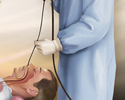Bronchoscopic culture
Culture - bronchoscopicBronchoscopic culture is a laboratory exam to check a piece of tissue or fluid from the lungs for infection-causing germs.
-
How the Test is Performed
A procedure called bronchoscopy is used to get a sample (biopsy or brush) of lung tissue or fluid.
The sample is sent to a laboratory. There, it is placed in a special dish (culture). It is then watched to see if bacteria or other disease-causing germs grow. Treatment is based on the results of the culture.
-
How to Prepare for the Test
Follow your health care provider's instructions on how to prepare for bronchoscopy.
-
How the Test will Feel
Your provider will tell you what to expect during your bronchoscopy. Most times, it's performed under conscious sedation (heavily sedated), or under general anesthesia (fully asleep) so you will likely not remember much from the procedure.
-
Why the Test is Performed
A bronchoscopic culture is done to find infection in the lung that cannot be accurately detected by a sputum culture. The procedure may find the following things, such as:
- Abnormal secretions
- Abnormal lung tissue
- Abscesses
- Blockage of the airway, most often due to cancer or foreign bodies
- Inflammation
- Obstructive lesions, such as cancer or foreign bodies
-
Normal Results
No organisms are seen on the culture.
-
What Abnormal Results Mean
Abnormal culture results usually indicate a respiratory infection. The infection may be caused by bacteria, viruses, parasites, mycobacteria, or fungi. The results of the culture will help determine the best treatment.
Not all organisms found with bronchoscopic culture need to be treated. Your provider will tell you more about this, after taking into account a lot of information to determine if treatment is needed.
-
Risks
Your provider can discuss the risks of the bronchoscopy procedure with you.
References
Beamer S, Jaroszewski DE, Viggiano RW, Smith ML. Optimal processing of diagnostic lung specimens. In: Smith ML, Leslie KO, Wick MR, eds. Practical Pulmonary Pathology: A Diagnostic Approach. 4th ed. Philadelphia, PA: Elsevier; 2024:chap 3.
Kupeli E, Mehta AC. Diagnostic bronchoscopy: basic techniques. In: Broaddus VC, Ernst JD, King TE, et al, eds. Murray and Nadel's Textbook of Respiratory Medicine. 7th ed. Philadelphia, PA: Elsevier; 2022:chap 26.








